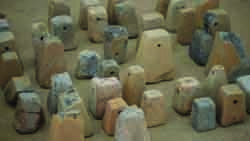Textile tools of the past
Throughout ancient times, textiles were vital for clothing, furnishings, sacks to store and carry things in, and for sailcloth. Textile trade had a profound socioeconomic impact. Archaeological records do not often contain preserved textiles from that time, since textiles are perishable in nature and require specific environmental conditions for their preservation. However, recovering the tools that were used to produce them can supply enormous amounts of information. In light of this, the DIASPORA (West and East: Textile technologies and identities in the 1st millennium B.C. South Italy and Cyprus) project examined textile technologies and identities within the socio-cultural dynamics of the Iron Age/Archaic and the early Classical periods (8th to 5th centuries BCE) in South Italy, Sicily and Cyprus. These areas were subject to Greek and Phoenician influence. Emphasis was primarily on the archaeological sites of Monte Iato, Segesta and Mozia in western Sicily and San Vito dei Normanni and Cavallino in Apulia. In Cyprus, tool material from the sites of Idalion and Kition-Bamboula was also examined. The project applied phenomenology as an analytical framework. In this approach, the researcher plays the role of an active participant. Artefacts are viewed in a way that transcends both the user and the maker. It was concluded that loom weights are culturally important in that they are an expression of local traditions and mirrors of their cultural settings. A common thread through the project was the significance of cultural heritage. Moreover, experimental archaeology testing was conducted on replicas of some of the studied textile tools. An inscribed loom weight with an important inscription was discovered at Segesta and over a thousand loom weights were documented. Significant findings led the project team to conclude that fine and very fine textile fabrics were manufactured in particular at the sites in Sicily and South Italy. Career development and training initiatives were included in DIASPORA's co-organisation of an international conference ‘Treasures of the Sea. Seasilk and shell purple-dye in antiquity’. Additionally, courses in weave and dyeing techniques as well as fibre identification were conducted. Project results have been disseminated at numerous academic conferences and in several articles, now in press. These are useful to archaeologists, historians and textile specialists. Furthermore, the findings make a significant contribution to the fields of anthropology, ancient epigraphy, cultural heritage, conservation and museum curating.







